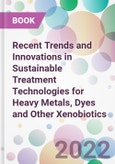This book integrates knowledge about innovative technologies developed in the past decade with information about commercial-scale processes. It is written with the objective to help readers to understand the potential of achieving sustainability and high efficiency in wastewater treatment. The book presents nine chapters. Chapter 1 details the types of wastewater, its characteristics, and the major commercial-scale strategies employed to treat wastewater.
Chapter 2 details the different types of physicochemical methods utilized for the remediation of heavy metals, dyes, and xenobiotics. Chapters 3 and 4 highlight innovations in the advanced oxidation process and adsorption for remediation of such complex molecules, respectively. Chapters 5, 6, and 7 highlight the recent innovations in bioremediation of xenobiotics, heavy metals, and dyes, respectively. Finally, chapters 8 and 9 discuss the latest technologies, prevailing bottlenecks, and the path ahead towards commercial viability and environmental sustainability in both physico-chemical and biological treatment processes.
Chapter 2 details the different types of physicochemical methods utilized for the remediation of heavy metals, dyes, and xenobiotics. Chapters 3 and 4 highlight innovations in the advanced oxidation process and adsorption for remediation of such complex molecules, respectively. Chapters 5, 6, and 7 highlight the recent innovations in bioremediation of xenobiotics, heavy metals, and dyes, respectively. Finally, chapters 8 and 9 discuss the latest technologies, prevailing bottlenecks, and the path ahead towards commercial viability and environmental sustainability in both physico-chemical and biological treatment processes.
Table of Contents
Chapter 1 Introduction1. Preface
2. Characterization
2.1. Coke Oven Wastewater
2.2. Rice Mill Wastewater
2.3. Pharmaceutical Wastewater
2.4. Leather Industry Wastewater
3. Treatment Strategies
3.1. Coke Oven Wastewater
3.2. Rice Mill Wastewater
3.3. Pharmaceutical Wastewater
3.4. Leather Industry Wastewater
- Conclusion
- Consent For Publication
- Conflict Of Interest
- Acknowledgement
- References
1. Introduction
2. Conventional Wastewater Treatment Process And Equipment
2.1. Adsorption
2.2. Air Stripping
2.3. Liquid-Liquid Extraction
2.4. Emulsion Liquid Membrane
2.5. Advanced Oxidation Process
2.6. Fenton Oxidation
2.7. Ozonation
2.8. Photocatalytic Treatment
3. Processes In High Gravity Equipment
3.1. Rotating Packed Bed
3.2. Micromixing
3.3. Gas And Liquid Mass Transfer Coefficient
3.4. Allowable Throughput
3.5. Spinning Disc Reactor
- Conclusion
- Consent For Publication
- Conflict Of Interest
- Acknowledgement
- References
1. Introduction
2. Advanced Oxidation Process (Aop)
1.1. Ozone Assisted Aops
1.2. Ultraviolet Assisted Aops
1.3. Fenton Assisted Aops
1.4. Sonolysis Assisted Aops
1.5. Photocatalysis Assisted Aops
1.6. Sulfate Radical-Based Aops
2. Removal Of Dyes By Aops Application
2.1. Removal Of Dyes Using Ozonation Assisted Aops
2.2. Removal Of Dye Using Uv-Assisted Aops
2.3. Removal Of Dye Using Fenton Oxidation
2.4. Removal Of Dye Using Sonolysis
2.5. Photocatalytic Removal Of Dyes
3. Removal Of Xenobiotics By Aops Application
3.1. Removal Of Xenobiotics By Ozonation-Based Aops
3.2. Removal Of Xenobiotics By Uv-Based Aops
3.3. Removal Of Xenobiotics By Fenton And Photo-Fenton Process
3.4. Removal Of Xenobiotics By Sonolysis
3.5. Removal Of Xenobiotics By Photochemical Degradation
4. Removal Of Heavy Metal Using Aops
4.1. Heavy Metal Removal Using Ozonation-Based Aops
4.2. Heavy Metal Removal Using Uv-Assisted And Photocatalytic Aops
4.3. Heavy Metal Removal Using Fenton Oxidation-Based Aops
- Conclusion
- Consent For Publication
- Conflict Of Interest
- Acknowledgement
- References
1. Introduction
2. Preparation, Characterization, And Mechanism Of Various Adsorbents
2.1. Activated Carbon (Gac, Pac, Biochar)
2.2. Zeolites And Clay Materials
2.3. Biosorbent (Agricultural Residue And Microbial Biomass)
2.4. Carbon Nanotubes
2.5. Graphene
2.6. Hybrid
3. Influence Of Process Parameters
4. Modeling Of Adsorption Process
4.1. Adsorption Isotherm
4.2. Adsorption Kinetics
4.2.1. Surface Reaction Models (Srm)
4.2.2. Mass Transfer Models (Mtm)
4.3. Example Of Unconventional Mathematical Modeling
- Conclusion
- Consent For Publication
- Conflict Of Interest
- Acknowledgement
- References
1. Introduction
1.1. Heavy Metals From Mining, Processing And Industrial Effluents
1.2. Heavy Metals Used In Agriculture
1.3. Air Mediated Sources Of Heavy Metals
1.4. Sources Of Dyes
2. Remediation And Related Technology
2.1. Phytoextraction
2.2. Phytostabilization
2.3. Rhizofiltration
2.4. Phytovolatilization
2.5. Phytotransformation/ Phytodegradation
2.6. Plant-Based Remediation Of Heavy Metals And Dyes
2.7. Whole Plant For Dye Removal
2.8. Plant Derived Material For Heavy Metal
2.9. Plant Derived Material For Dye
2.10. Plant Synthesized/Conjugated Material For Heavy Metals
2.11. Plant Synthesized/Conjugated Material For Dye Removal
3. Microbial Based Remediation
3.1. Whole Cells For Heavy Metals
3.2. Whole Cells For Dye Removal
3.3. Microbial Derived/Conjugated Remediation Of Heavy Metals
3.4. Microbial Derived/Conjugated Remediation Of Dye
3.5. Microbial Synthesized/Conjugated Material For Heavy Metals
3.6. Microbial Synthesized/Conjugated Material For Dye
- Conclusion
- Consent For Publication
- Conflict Of Interest
- Acknowledgements
- References
- Chandrani Debnath, Biswanath Bhunia, Bikram Basak And Muthusivaramapandian Muthuraj 1. Introduction
2.1. Biosorption Of Dyes
2.1.1. Biomaterials For Adsorption
2.1.2. Factors Influencing Biosorption Of Dyes
2.2. Bioaccumulation And Degradation Of Dyes
2.2.1. Factors Affecting Biodegradation
2.3. Biochar, And Biochar-Based Nanocomposites
2.4. Porous Materials And Metal-Organic Frameworks (Mofs)
2.5. High-Performance Forward-Osmosis Membrane
3. Sustainable Strategies For Bioremediation Of Dyes
4. Bottlenecks & Future Prospects
- Conclusion
- Consent For Publication
- Conflict Of Interest
- Acknowledgement
- References
- Nibedita Mahata, Biswanath Bhunia, Muthusivaramapandian Muthuraj And Ramesh Kumar 1. Introduction
2.1. Membrane Filtration
2.2. Activated Carbon Filtration
2.3. Adsorption
2.4. Advanced Oxidation Processes
2.5. Dissolved Air Floatation (Daf)
2.6. Coagulation-Flocculation And Sedimentation
2.7. Electrocoagulation (Ec) Process
3. Criteria For Sustainable Wastewater Treatment Technologies 185 3.1. Performance
3.2. Cost
3.3. Sustainability
3.3.1. Resource Recovery
3.3.2. Energy Management
3.3.3. Solid Volume Reduction
3.4. Prospects In Physico-Chemical Remediation
- Conclusion
- Consent For Publication
- Conflict Of Interest
- Acknowledgement
- References
- Bidhu Bhusan Makut, Mayurketan Mukherjee, Gargi Goswami And Debasish Das 1. Introduction
2.1. Bacterial Treatment
2.1.1. Challenges Associated With Bacterial Bioremediation
2.2. Treatment Of Wastewater Using Microalgae
2.2.1. Challenges Associated With Microalgal Bioremediation
2.3. Mycoremediation Of Wastewater Treatment
3. Consortium Aiding Enhanced Bioremediation
3.1. Pivotal Role Of Microalgae-Bacteria Consortium In Wastewater Treatment
3.1.1. Mutualistic Association
3.2. Microalgae-Bacteria Based Wastewater Treatment
Author
- Biswanath Bhuni
- Muthusivaramapandian Muthura








